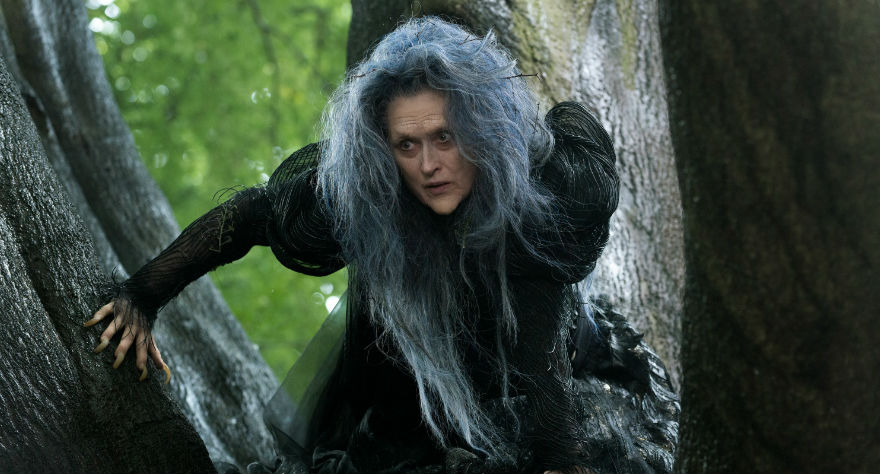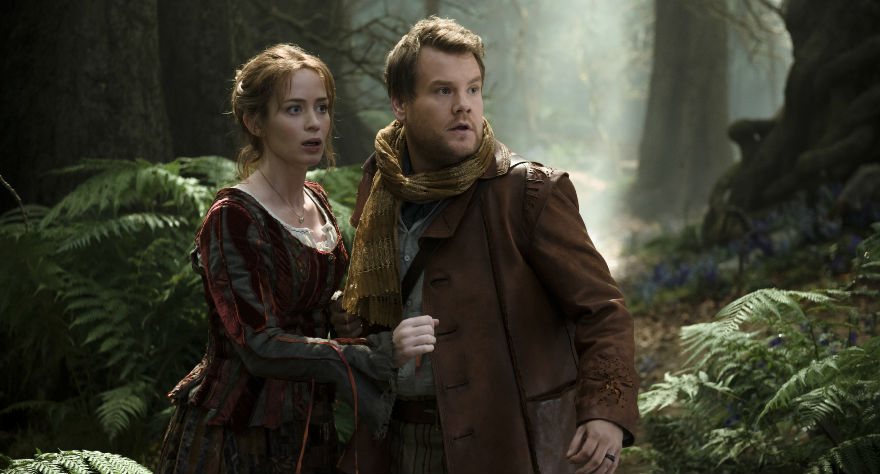
With so many big studio cash-in adaptations poisoning our theaters and stealing our money, it's nice to see one come along that actually deserves our attention.

With so many big studio cash-in adaptations poisoning our theaters and stealing our money, it's nice to see one come along that actually deserves our attention.
It took about 30 years, but Stephen Sondheim and James Lapine’s musical fairytale cocktail, Into the Woods, has finally expanded from stage to big screen courtesy of the Mouse House and Chicago director Rob Marshall. I wasn’t familiar with the original stage production going into the film, but it wasn’t at all hard to recognize Into the Woods‘ theater roots once I heard the exuberant, winky dialogue (Lapine adapts his own words to screen) and started tapping my foot to the infectious Sondheim tunes being belted out by some of the Brothers Grimm’s most famous characters. The film’s final act feels too deflated to call this overdue screen adaptation a certified triumph, but the first two thirds are so cheeky, unencumbered, and flat-out fun that it’s hard not to give Into the Woods a hearty recommendation, especially with all this holiday cheer hanging in the air.
The story takes several popular Grimm characters–including Rapunzel, Cinderella, and Jack (of beanstalk fame)–and several new characters of Lapine’s creation and throws them into the twisty, shadowy bowela of the titular woods, so that we can watch these familiar childhood characters sing, argue, fall in love, and interact in ways we’ve never imagined! I know, I know…that isn’t really the case anymore. The fantasy mash-up idea has long since lost its novelty since the musical debuted in the mid-’80s (Shrek, Once Upon a Time, Enchanted, the excellent comic book Fables, and many others have aped the gimmick), but it’s as potent (and trendy) today as it ever has been.
While an ensemble piece through and through, the plot is fueled by the plight of two central characters, The Baker (James Corden) and his Wife (Emily Blunt), who have always wished for a child, though their wish never came true. When an old Witch (Meryl Streep, unhinged) blows into the bakery in the showiest way possible (wind, thunder, flashes of light), the couple learns that they’ve been infertile all this time due to a curse she cast on The Baker when he was only a child, after his father stole magic beans from her garden. (In another act of revenge, she also stole The Baker’s infant sister, Rapunzel.) The Witch offers to lift the curse if The Baker can pull off an improbable scavenger hunt in the woods, fetching her four ingredients she needs for a potion: a cow as white as milk, a cape as red as blood, hair as yellow as corn, and a slipper as pure as gold. Sounds tasty.

The carriers of said items, as you might have guessed, happen to be the Brothers Grimm all-stars: the slipper is Cinderella’s (Anna Kendrick), who thrice flees through the woods after abandoning her prince at the royal dance; the cow, aptly named Milky White, belongs to young Jack (Daniel Huttlestone, his campy, old-school British accent unintentionally hilarious); the cape is, of course, Red Riding Hood’s (Lilla Crawford); and the corn-yellow hair comes from the pretty head of The Baker’s long-lost sister, the lovely Rapunzel (Mackenzie Mauzy).
Secondary characters make memorable appearances, from Johnny Depp as Red Riding Hood’s Big Bad Wolf (their scene is uncomfortable, though the sexual tension has apparently been slightly tamed from the stage version), Tracey Ullman as Jack’s mother, and Frances de la Tour as one of Jack’s giants. Chris Pine and Billy Magnussen play Cinderella and Rapunzel’s princes, respectfully, and their epic duet in front of a waterfall, “Agony”, a witty lover’s lament, is one of the funniest things I’ve seen all year. (I laughed so long and hard my wife was thoroughly embarrassed, though that’s hardly an uncommon occurrence with us.)
The characters zip and weave through the trees, bumping into each other now and again, each in a mad search for their own personal “happily ever after”. The Bakers find, then lose, then find again The Witch’s items, while the Grimm characters play out their familiar stories with slightly remixed scenarios. True to the fairytale tradition, all their wishes do, indeed, come true. But that’s not where the story ends; it’s where the real story begins. “Be careful what you wish for” the film’s ad campaign warns us.
The film’s final third sees the characters return to the woods to learn life’s hard lessons, with some of our beloved heroes biting the dust for good. The woods represent the cruelty and sadness of the real world, and forcing historically idealized characters like Cinderella to reckon with wretched things like infidelity. (Her prince is charming no doubt, but is he faithful?) What’s the true cost of our wishes coming true? Is a wish worth making the ultimate sacrifice? This concept of subverting and sobering up our childhood notions of the “fairy tale ending” is brilliant and forever relevant.
Marshall and Lapine handle the 180 degree tonal shift from peachy-keen Disney adventure to dark, somber drama quite well, but the film ends with such low energy compared to the first two acts that it feels comparatively bland. The later musical numbers begin to feel like a homogeneous series of music videos, with the same nighttime forest background providing the numbers little in the way of visual distinctiveness. The songs feel really packed-in, too; the story’s message has a harder time ringing true when we’re so musically fatigued.
The wealth of superb performances are the film’s greatest virtue, chiefly among them being the formidable Streep, whose keen comedic timing is on full display. Corden and Blunt shine as well, with a natural rapport that makes them excellent anchors for the story. Unsurprisingly, the theatrically-trained Kendrick’s the best singer of the bunch, though the less vocally-gifted Pine makes up for his inexperience with flamboyance, prancing and preening and posing his way through the film with the wackiness of a cheap stage show on the Las Vegas strip.
Of the things Into the Woods gets right, perhaps the most pleasing is the way it embraces its origins as a stage production. CGI is kept to a minimum, and practical effects are used skillfully and tastefully. The sets (which all appear to be practical, not digital) are terrific, too, with the ominous trees and misty swamps looking convincing while never hiding the fact that they were built by human hands. With so many big studio cash-in adaptations poisoning our theaters and stealing our money, it’s nice to see one come along that actually deserves our attention.